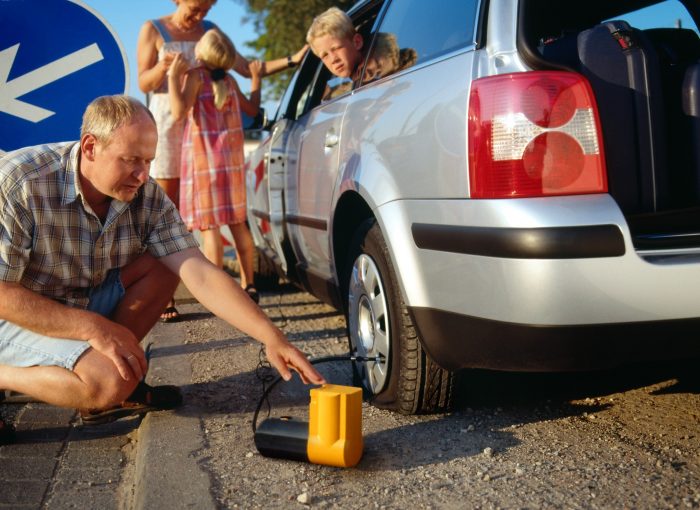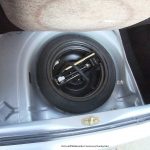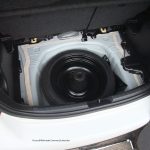We get a lot of questions about these. It’s because the majority of new cars don’t come with a spare wheel. Instead, they’re either equipped with a space saver spare wheel or an inflation kit. If the latter is the case, you’ll find a small pack in the boot that contains a compressor and some fluid. But are these tyre inflation kits effective? Read on to find out.
How does a tyre inflation kit work?
These usually come in two parts. There’s a compressor for pumping tyres up and mousse that comes with a nozzle adapter enabling you to inject it into the tyre through the valve.
The compressor plugs into the car’s 12v power outlet (what used to be the cigarette lighter). It will then pump mousse and air into the tyre. The air pressure forces the mousse towards the hole where the air is escaping. That forces the mousse to seal the hole and keep the air in the tyre.
Are tyre inflation kits any good?
That depends on the kind of puncture you’ve had. If it’s a small hole in the central tread area, say caused by a nail, then yes, an inflation kit should work. However, if you’ve hit an object and perhaps gashed the tyre’s sidewall, then an inflation kit is pretty useless. The air pressure will simply force the mousse out through the hole.
It also depends on how quickly you’ve noticed the puncture and therefore stopped. If you’ve driven some distance with low tyre pressure, the tyre may well have overheated and shredded.
All that said, in certain circumstances, inflation kits are very good. They could well get you home and mean you don’t have to change the wheel. It’s something that might appeal to anyone who isn’t confident with a jack and wheel brace. Tyre maker Continental claims that an inflation kit will be suitable in about 70% of punctures.
That said, if you’ve had a puncture in Calais, a tyre inflation kit isn’t going to get you to Cannes. What it will do is enable you to get a few miles to a garage or tyre retailer so that you can have the tyre fixed or buy a replacement for it. Continental says you can drive 125 miles after using an inflation kit.

You can get aftermarket kits
If you like the sound of these, you can buy them over the counter from motor retailers. They cost anywhere between about £6 and £23. However, if you buy one from the car maker, it’s likely to be pricier.
That said, you do get what you pay for. The more money you hand over, the more high quality the kit is likely to be. It could also come with a carrying case which will ensure everything is kept together in the boot rather than flying around all over the place.
Not all kits are the same. The key ingredient is the compressor and these vary in power. The more power a compressor has, the quicker it will re-inflate the tyre. It’s also worth checking how clear the gauges are and how long the hoses are.
But they may mean you can’t repair the tyre
Sometimes punctured tyres can be repaired, depending on the position of the hole. It also depends on how much underinflated tyres have been driven without sufficient air. The more miles, the more damage that’s likely to occur to the tyre’s structure and the less likely it is a repairer will be able to work their magic. Read all about tyre repairs here.
It’s also worth remembering that the mousse used with inflation kits is by its nature sticky and fairly unpleasant stuff to deal with. Frequently fast fit operations will refuse to repair tyres because cleaning out the mousse to make the repair is too time consuming, messy and difficult.
What they’d rather do is charge you for a new tyre instead of just a repair. Then they get more money and their technician doesn’t have to get all messy. It’s a win-win – for them. What you should do is insist that the tyre can be repaired (assuming of course the damage is in the ‘minor repair area’ and the tyre can be legally fixed.)
You could always replace the inflation kit with a spare tyre
Unless it’s a specialist sportscar with no boot, or perhaps a model with two different sizes of tyre front to back, there will doubtless be a space in or under the boot for a spare wheel. And usually for around £100 you can buy a space saver spare from the manufacturer.
Most cars now have alloy wheels. And to prevent nerks nicking them for their 15-year old Corsas, car makers give them locking wheel nut keys. This means if you need to change a wheel, you’ll need a locking wheel nut key.
With an inflation kit you shouldn’t need one at the roadside. But inflation kits do only offer a very temporary repair. And you will have to get the tyre changed at some point. The good news is, most breakdown organisations and garages have tools that will remove locking wheel nuts if you can’t find your key.

I’ve been writing about cars and motoring for more than 25 years. My career started on a long-departed classic car weekly magazine called AutoClassic. I’ve since pitched up at Autosport, Auto Express, the News of the World, Sunday Times and most recently the Daily Telegraph. When I’m not writing about cars and motoring, I’m probably doing some kind of sport or working in my garden.







